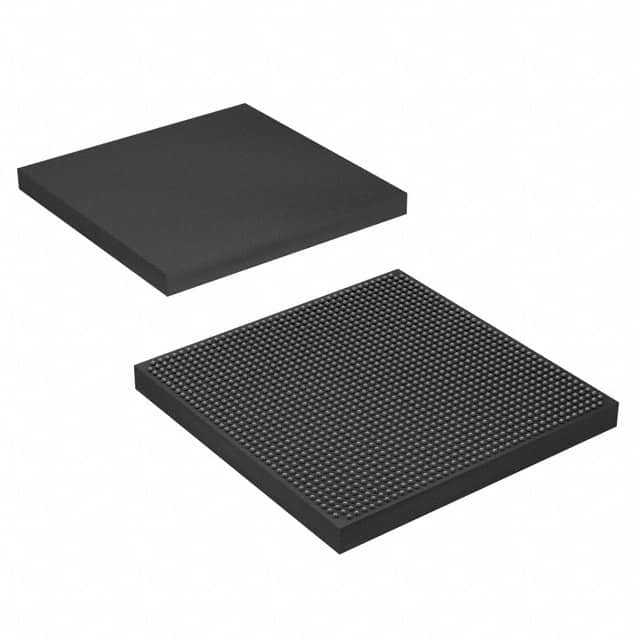5SGXMA3K3F40C2N
Product Overview
Category
The 5SGXMA3K3F40C2N belongs to the category of Field Programmable Gate Arrays (FPGAs).
Use
FPGAs are integrated circuits that can be programmed and reprogrammed to perform various digital functions. The 5SGXMA3K3F40C2N is specifically designed for high-performance applications.
Characteristics
- High-performance FPGA with advanced features
- Large capacity and high-speed processing capabilities
- Flexible and reconfigurable design
- Low power consumption
- Robust and reliable performance
Package
The 5SGXMA3K3F40C2N comes in a compact and durable package, ensuring protection during handling and installation.
Essence
The essence of the 5SGXMA3K3F40C2N lies in its ability to provide a versatile and powerful platform for implementing complex digital systems.
Packaging/Quantity
The 5SGXMA3K3F40C2N is typically packaged individually and is available in various quantities depending on the customer's requirements.
Specifications
- FPGA Family: Stratix V
- Logic Elements: 358,400
- Embedded Memory: 21,196 Kbits
- DSP Blocks: 3,888
- Maximum User I/Os: 1,280
- Operating Voltage: 1.0V
- Operating Temperature Range: -40°C to +100°C
- Package Type: F40
- Pin Count: 1517
Detailed Pin Configuration
For a detailed pin configuration diagram of the 5SGXMA3K3F40C2N, please refer to the official product datasheet provided by the manufacturer.
Functional Features
The 5SGXMA3K3F40C2N offers a range of functional features, including:
- High-speed data processing
- Support for various communication protocols
- On-chip memory resources
- Flexible I/O interfaces
- Advanced clock management
- Built-in security features
Advantages and Disadvantages
Advantages
- High-performance capabilities
- Reconfigurable design allows for flexibility in system development
- Large capacity enables complex digital designs
- Low power consumption contributes to energy efficiency
- Robust and reliable performance ensures stable operation
Disadvantages
- Higher cost compared to other programmable logic devices
- Steeper learning curve for programming and utilizing the full potential of the FPGA
Working Principles
The 5SGXMA3K3F40C2N operates based on the principles of reconfigurable logic. It consists of an array of configurable logic blocks interconnected through programmable routing resources. The user can program the FPGA to implement desired digital functions by configuring the interconnections and functionality of the logic blocks.
Detailed Application Field Plans
The 5SGXMA3K3F40C2N finds applications in various fields, including:
- Telecommunications: Used in high-speed data transmission systems, network routers, and switches.
- Aerospace and Defense: Employed in radar systems, avionics, and military communication equipment.
- Industrial Automation: Utilized in control systems, robotics, and machine vision applications.
- Medical Devices: Integrated into medical imaging systems, patient monitoring devices, and diagnostic equipment.
- Research and Development: Used as a prototyping platform for developing custom digital systems.
Detailed and Complete Alternative Models
- 5SGXEA7K2F40C2N
- 5SGXEB6R2F40C2N
- 5SGXEB9R2F40C2N
- 5SGXEBR2H40C2N
- 5SGXEBR6H40C2N
These alternative models offer similar capabilities and can be considered as alternatives to the 5SGXMA3K3F40C2N, depending on specific project requirements.
Note: The above information is based on the available data at the time of writing and may be subject to change. For the most accurate and up-to-date information, please refer to the official documentation provided by the manufacturer.
قم بإدراج 10 أسئلة وإجابات شائعة تتعلق بتطبيق 5SGXMA3K3F40C2N في الحلول التقنية
Sure! Here are 10 common questions and answers related to the application of 5SGXMA3K3F40C2N in technical solutions:
Q: What is the 5SGXMA3K3F40C2N FPGA used for? A: The 5SGXMA3K3F40C2N is a Field-Programmable Gate Array (FPGA) that can be used for various applications such as high-performance computing, networking, and signal processing.
Q: What are the key features of the 5SGXMA3K3F40C2N FPGA? A: Some key features include a large number of logic elements, high-speed transceivers, embedded memory blocks, and support for various communication protocols.
Q: Can the 5SGXMA3K3F40C2N FPGA be reprogrammed? A: Yes, FPGAs are designed to be reprogrammable, allowing users to modify the functionality of the device even after it has been deployed.
Q: How does the 5SGXMA3K3F40C2N FPGA compare to other FPGAs in terms of performance? A: The 5SGXMA3K3F40C2N offers high-performance capabilities with its advanced architecture, making it suitable for demanding applications that require fast processing and data throughput.
Q: What development tools are available for programming the 5SGXMA3K3F40C2N FPGA? A: Intel Quartus Prime is the primary development tool used for programming and configuring the 5SGXMA3K3F40C2N FPGA. It provides a comprehensive environment for design entry, synthesis, simulation, and verification.
Q: Can the 5SGXMA3K3F40C2N FPGA interface with other components or devices? A: Yes, the FPGA has various I/O interfaces such as GPIO pins, high-speed transceivers, and support for communication protocols like PCIe, Ethernet, USB, and more.
Q: What are some typical applications of the 5SGXMA3K3F40C2N FPGA? A: The FPGA can be used in applications such as data centers, telecommunications, video processing, software-defined networking, radar systems, and high-performance computing clusters.
Q: Does the 5SGXMA3K3F40C2N FPGA require any external components for operation? A: Yes, the FPGA typically requires external power supplies, clock sources, and may need additional components depending on the specific application requirements.
Q: Can the 5SGXMA3K3F40C2N FPGA be used in safety-critical applications? A: Yes, the FPGA can be used in safety-critical applications, but it is important to follow proper design practices, verification, and validation processes to ensure reliability and functional safety.
Q: Are there any limitations or considerations when using the 5SGXMA3K3F40C2N FPGA? A: Some considerations include power consumption, thermal management, timing constraints, and the need for expertise in FPGA design and programming to fully utilize its capabilities.


